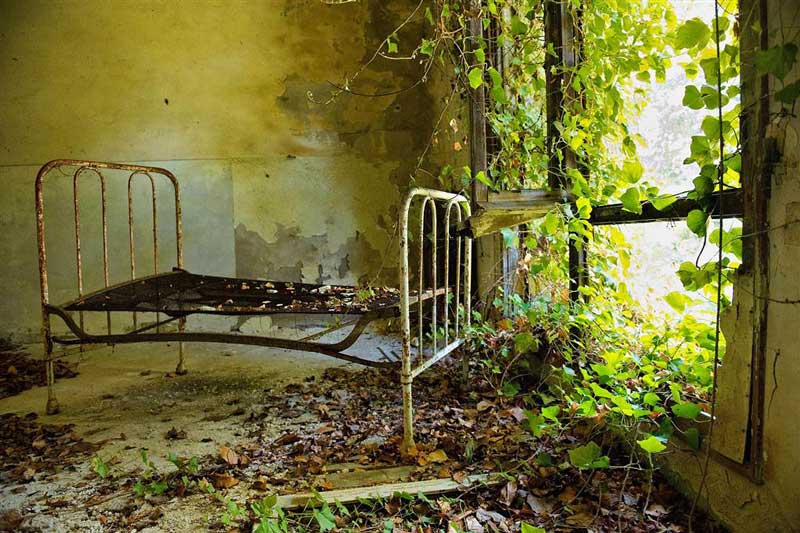
In April 2014, the Italian state announced the online auction of an uninhabited island in the Venetian lagoon on a 99 year lease to raise revenue with the hope that the buyer would reconstruct the remains of the hospital building into a luxury hotel. However, it did not work out, and the island remained vacant to date. The island in question is called Poveglia, known as being haunted by ghosts of plague victims, lunatics, and lobotomizing doctors. Poveglia is a small, fan-shaped island, located around 1500 feet (457 m) off the shore of the Lido in the south of the lagoon that buffers Venice from the Adriatic Sea.
At the base of the fan, and separate from it, stands the dilapidated structure of a 17th-century octagonal fort. The main part of the island, divided by a narrow canal, is mostly covered by a derelict building of a hospital dating from the 19th to early 20th centuries, along with its garden, devoured by thick tangles of undergrowth and unwanted vegetations. Another important visible structure on the island is a bell tower that belonged to the 12th-century church of San Vitale, which was demolished in 1806. Later, the tower was used as a lighthouse.

Due to its history full of tragic events going back thousands of years, the tiny Poveglia Island has become notorious as haunted. For centuries, it had been a refuge, place of exile, and dumping ground for the diseased, dying, and the deceased.
During the ancient days of the Roman Empire, the island was used to house victims of the plague to protect the rest of the country, forcing inflicted people to live and die in isolation. Again, in 1348 when the severe epidemic Bubonic Plague killed nearly two-thirds of Europe’s population, Venice dispatched the inflicted, even the symptomatic people, to the island to die there unattended, miles away from the mainland. Within no time, the bodies of the deceased overcrowded the island, and thousands were dumped into mass graves, others were burned on giant pyres. The fire would burn again in 1630 when the second plague pandemic started, and the Black Death ravaged the country. It is said that Poveglia Island had more than 160,000 infected souls living out their final there, and fifty percent of its soil consists of human remains.

In 1776 when the island came under the jurisdiction of the Public Health Office, it was turned into a checkpoint for the goods and people coming to and going from Venice by ship. However, in 1793 it was transformed into a temporary confinement station when plague was detected in several persons on two ships. It became a permanent quarantine island in 1805, under the rule of Napoleon, who took the advantage of the ghostly legends and the defendable position of the island to use it to store weapons and gunpowder.
He destroyed the old church of San Vitale and converted its bell tower into a lighthouse.

Much later, in 1922, the existing buildings were converted into an asylum for the mentally ill, which was actually used as a place of exiled prison rather than rehabilitation. It is said that the isolation and privacy offered by the island allowed for disreputable scientists and doctors to do as they pleased to their patients. According to local legends, in the 1930s, a doctor at the asylum used to perform strange experiments on helpless patients, tortured and butchered them horribly. He believed that lobotomies, a surgical operation involving incision into the prefrontal lobe of the brain, were a great way to treat and cure mental illness. For experiments, he used to take the selected patients to the bell tower, and performed lobotomies on them in a barbaric way, using hammers, chisels, and drills with no anesthesia or concern for sanitation. It is said that the screams and wails of those tortured souls were heard even across the island.

People say, eventually the doctor lost his mind, and one day after climbing to the top of the bell tower, he flung himself to his death. However, some say that he was either pushed by an angry spirit or by some of his furious patients. A nurse, supposed to witness his fall claimed that initially, he survived the fall, but a misty ghost overcame his body and choked him to death.
Nevertheless, the existence of the asylum on Poveglia seems to be confirmed by a sign for the Psychiatric Department still visible among the derelict buildings, which was later used as a nursing home and long-term care facility, until its closure in 1968. However, based on its unusual history and the horrible stories centered around it, Poveglia eventually became notorious as a haunted island. It is believed by many that hundreds of thousands of tormented souls of the victims and suspected victims of plague who were forced onto the island to suffer and die in isolation, and the terribly tortured patients of the mental asylum, are still on the island.

Ultimately, the island was abandoned and was forbidden for decades, which attracted the attention of the ghost-hunters and the occasional thrill-seekers who ventured the island by hiring boats. It may sound strange and ridiculous, but many of those adventurers reported experiencing an unexplainable sense of being watched, followed along the corridors, seeing shadows on the walls, or pushed by invisible forces.